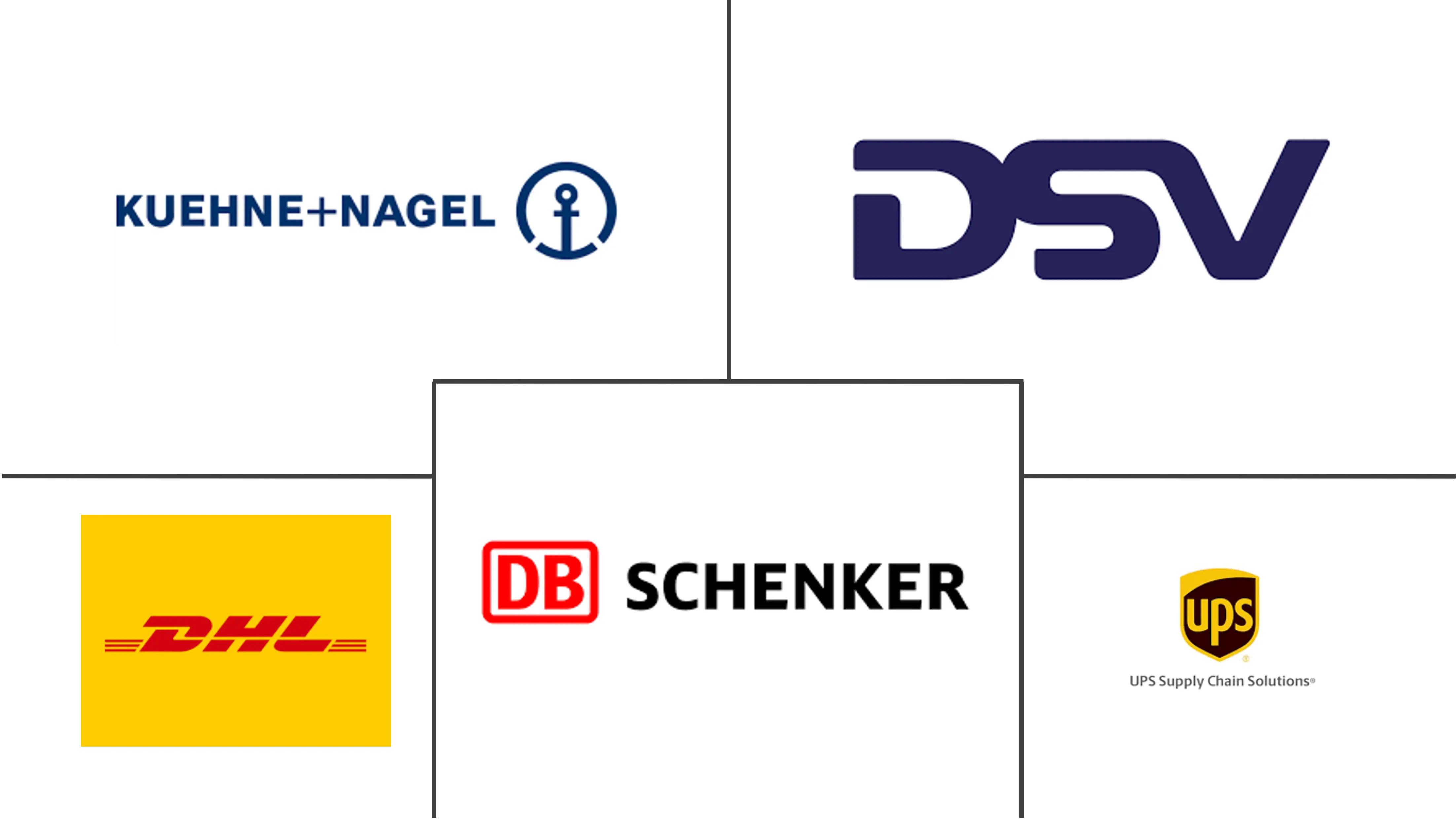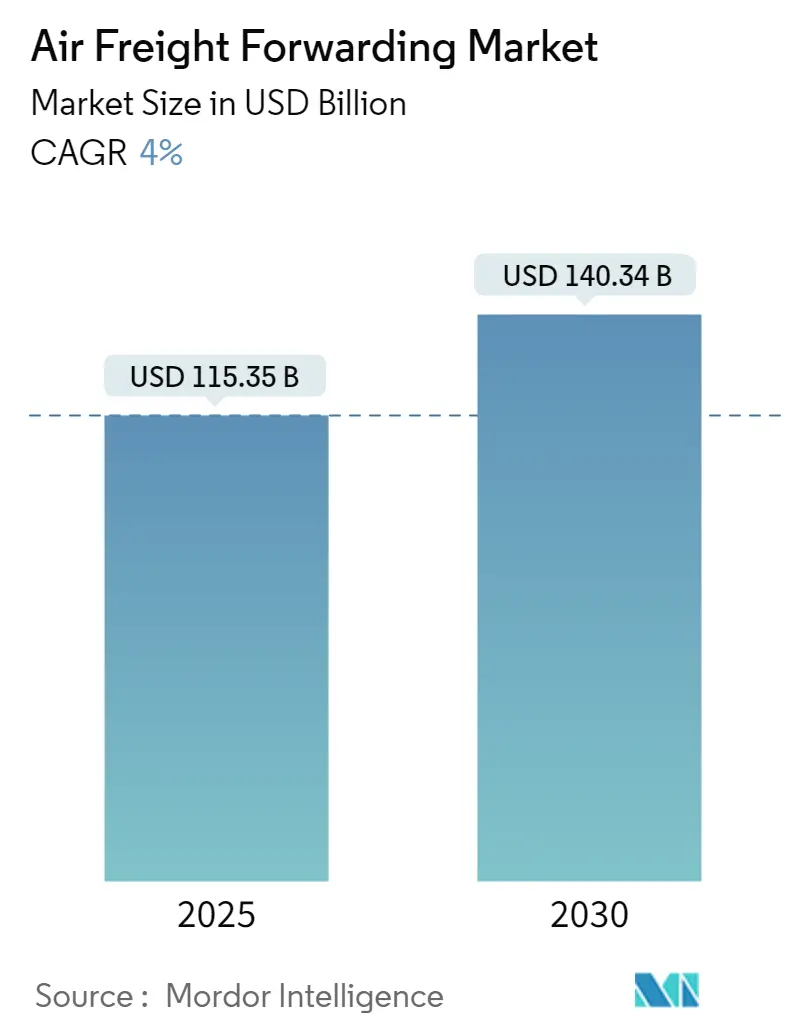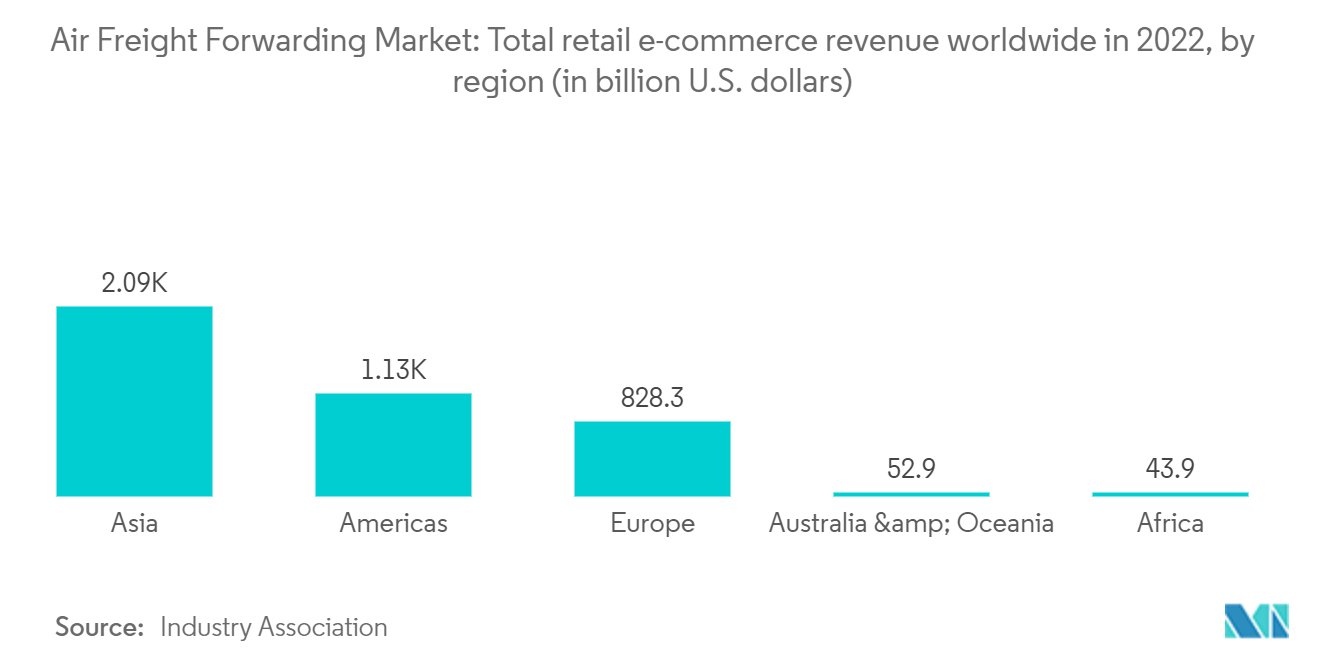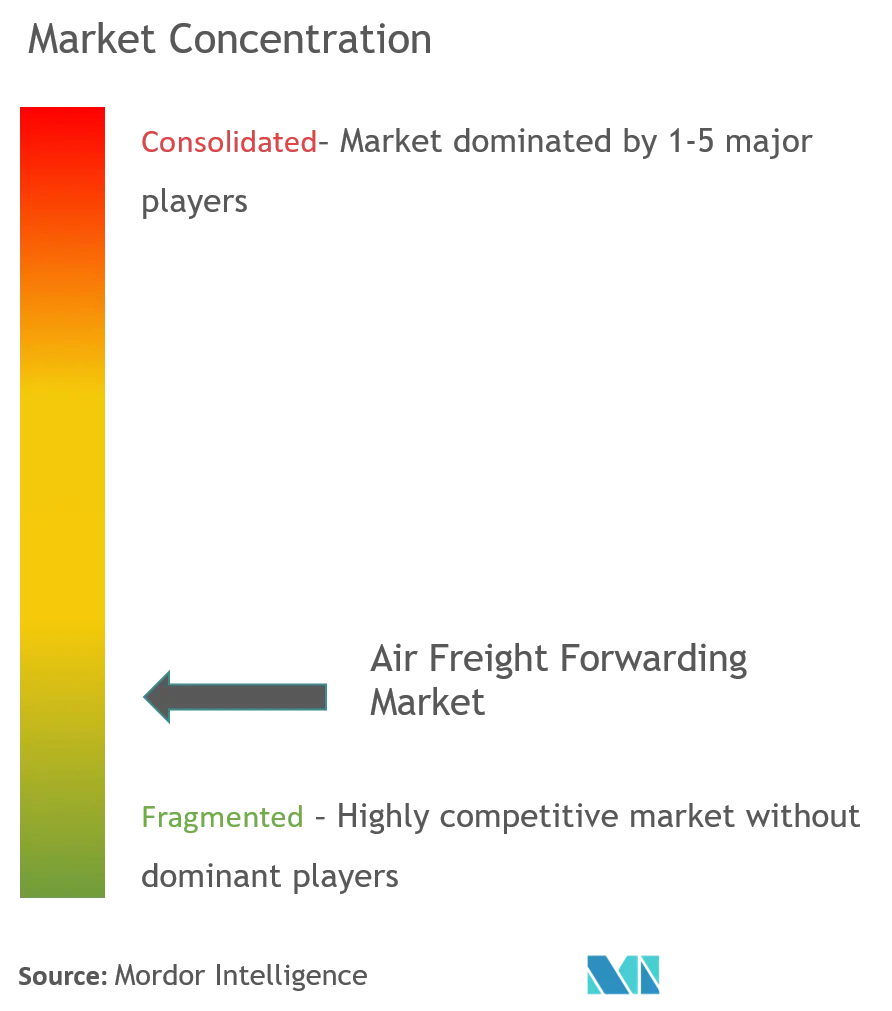Air Freight Forwarding Market Analysis
The Air Freight Forwarding Market size is estimated at USD 115.35 billion in 2025, and is expected to reach USD 140.34 billion by 2030, at a CAGR of 4% during the forecast period (2025-2030).
Although land and ship cargo transportation remain outstanding options, goods transport by air is considered the quickest and unhindered mode. Global air cargo demand, measured by cargo tonne-kilometers (CTKs), was 21.1 billion in October, increasing by 3.5% month-on-month (MoM). However, industry CTKs fell by 13.6% YoY compared to the same month in 2022 and were also 6.2% lower than the pre-pandemic levels in 2019. Seasonally adjusted (SA) air cargo demand softened slightly in October 2022, with a 2.3% MoM decline compared with September. Similar to the CTKs, SA CTKs contracted by 13.1% YoY and were 6.1% lower than in October 2019.
The air cargo industry persisted in October 2022, including high inflation rates in advanced economies, weak performance in the global flows of goods and services, the ongoing war in Ukraine, and the unusual strength of the US dollar. All of these factors put downward pressure on air cargo growth. The new export orders, historically a leading indicator for air cargo shipments, were still not buoyant. The global PMI remains below the critical 50 lines, suggesting continued contraction on average globally. China and Korea registered slightly higher new export orders in October 2022 than in September 2022, although they remained below 50. Other significant economies maintained a downward trend. Notably, Germany moved sideways at levels below 50 since March, signaling the continuous impact on the economy of the war in Eastern Europe.
Industry-wide air cargo capacity, measured by available cargo tonne-kilometers (ACTKs), increased by 2% compared with September. It produced an industry cargo load factor (CLF) of -7.4% in October, down from -7.0% in September. Industry SA ACTKs remained at about the same level compared with October 2021. Latin America achieved the highest YoY growth in SA ACTKs, at 20.3%. North America follows this with 3% YoY and the Middle East with 1.1% on the same basis. In comparison, regions that saw negative YoY growth in SA ACTKs this October were Africa (-7.5%), Europe (-5%), and Asia Pacific (-2.1%).
Air Freight Forwarding Market Trends
The increase in E-Commerce is driving the Market
E-commerce is forecast to grow 14% globally over the next five years. It creates an excellent opportunity for the air cargo industry, which witnessed its worst year in a decade due to the US-China tariff war. The global e-commerce industry, which makes up 16% of the total air cargo business, is projected to increase from USD 3.5 trillion in goods in 2022 to USD 7 trillion by 2025.
Some global carriers are working to gain a more significant share of the door-to-door delivery market that online shopping giants such as Amazon, Alibaba, and JD.com dominate. Dubai-based Emirates launched Emirates Delivers, Lufthansa includes Heyday, and British Airways parent IAG includes Zenda. However, IATA pointed out that despite this decline, November's performance was the best in eight months, with the slowest year-on-year rate of contraction recorded since March 2019.
The air cargo industry is well-positioned to capitalize on the growth in e-commerce. Air cargo is built to handle e-commerce, and approximately 80% of business-to-consumer cross-border e-commerce is transported by air. Air cargo is the preferred way of shipment for electronics due to the relatively small volume or tonnage compared to high value.
Thus, e-commerce is expected to fuel the air cargo industry, as online shopping boosts the demand for parcel delivery services across the globe. Air cargo can serve customers' needs and deliver goods with speed, efficiency, and reliability. The fast-growing cross-border e-commerce market and the rising domestic volumes sent by large and small e-retailers are driving growth in the global air cargo market.
APAC Largest Contributor to Air Freight
Irrespective of a downfall in the airline sector during the COVID-19 pandemic due to travel restrictions imposed in many Asian-Pacific countries, air cargo demand held up relatively well. However, supply chain disruptions and weakening business and consumer confidence due to increased uncertainties and rising unemployment adversely affected the air cargo businesses.
The Association of Asia-Pacific Airlines (AAPA) states that the air cargo sector is active in transporting essential medical equipment and supplies. Many Asian-Pacific countries encouraged several airlines to modify their passenger aircraft for air freight transport temporarily. While a standard passenger ATR72-600 can only carry 1.7 metric tons of cargo, its freighter-modified model can carry up to 8 metric tons, making it suitable for Pacific Island countries, given the region's demand and operating conditions.
South Korea accounted for the fourth-largest market share in the Asia-Pacific air cargo market share in 2022. South Korea includes one of the world's most significant air cargo carrier industries. It benefitted from strong demand when the collapse of passenger traffic reduced available transport space. Cargo sales were underpinned by the airline's strategy to increase the cargo plane operation rate and utilize idle passenger planes for transport, the airline said in a statement. Korean Air and Asiana Airlines, South Korea's two largest airlines, increased their operational earnings significantly in 2021, harnessing surging demand for cargo transport to help offset low passenger traffic.
The need for COVID-19 diagnostic kits and auto parts increased, and the sea cargo demand transferred to air transport, driving air cargo sales. Therefore, this leads to significant air cargo market growth in South Korea. Further, in June 2022, as Korean Air continues to position itself for high cargo demand, it is considering a move for the new wide-body freighters released by Airbus and Boeing in recent months. Long-term strong cargo demand also prompted Airbus to launch its A350 freighter last year in 2021 and Boeing its 777X freighter in January 2022. Thus, increasing the number of aircraft in cargo service will boost the Asia-Pacific air cargo market during the forecast period.
Air Freight Forwarding Industry Overview
The Air Freight Forwarding Market is moderately concentrated with the presence of prominent international players. Most service providers offer bundled solutions, such as packaging, labeling, documentation, charter services, and freight transportation. Some of the existing major players in the market include - DHL Supply Chain & Global Forwarding, Kuehne + Nagel, DB Schenker Logistics, DSV Panalpina, UPS Supply Chain Solutions, Expeditors International, Nippon Express, Bolloré Logistics, Hellmann Worldwide Logistics, and Kintetsu World Express.
Air Freight Forwarding Market Leaders
-
Kuehne + Nagel
-
DB Schenker
-
DSV Panalpina
-
UPS Supply Chain Solutions
-
DHL Supply Chain & Global Forwarding
- *Disclaimer: Major Players sorted in no particular order
Air Freight Forwarding Market News
- August 2023: National Airlines (NASDAQ: NATUAL), a division of national air cargo group, Inc., and Etihad Cargo (MENA, a.k.a. Etihad Cargo), a dynamic Middle East-based freight carrier, has entered into an Interline Agreement for the successful implementation of the International Civil Aviation Regulations 23rd (ICAIR23) program for the U.S. Postal Service. This interline agreement establishes a unique partnership between National Airlines, which has decades of experience in international freight transportation, and Etihad Cargo, which has a global commercial network.
- April 2022: DHL Supply Chain (a freight and logistics company) launched a strategic partnership with ReverseLogix (one of the leading cloud-based platforms to automate end-to-end reverse logistics for e-commerce brands). The decision came when DHL Supply Chain continued to see impressive growth for its e-commerce business, which saw a 15% annual growth rate over the 2021 peak season. It is coupled with total national retail returns climbing 78% to more than USD 761 billion. According to data issued by the National Retail Federation, this growth level was commensurate with substantial returns volume growth from 2020 to 2021.
- March 2022: Cargojet's recent bet on more aircraft led it to secure an expanded agreement with DHL Express. The pair announced a five-year cooperation agreement, with an option for another two years, for ACMI, CMI, charter, and dry leases. Canada's Cargojet already uses 12 aircraft for DHL, which is adding five 767Fs in 2022 and next to handle 'expected cargo volume.' DHL expanded its capacity in the Americas by 18% in the 2021 peak season and launched a weekly service from Vietnam to the US. Also, Cargojet recently signed purchase and conversion agreements for six more 777s, making eight more by 2026.
Air Freight Forwarding Industry Segmentation
Air freight is another name for air cargo, which is the shipment of goods via an air carrier. The value of air transport services is highest when it comes to the transportation of express shipments around the world. Like commercial or passenger air carriers, air freight operates through the same gateways.
The report provides a comprehensive background analysis of the market, covering the current market trends, restraints, technological updates, and detailed information on various segments and the competitive landscape of the industry. Additionally, the COVID-19 impact has been incorporated and considered during the study. The Air Freight Forwarding market is segmented by service (airlines, mail, and other services), destination (domestic and international), Geography (North America, Europe , Asia-Pacific , Middle East & Africa , South America). The report offers the market sizes and forecasts for the Air Freight Forwarding Market in value (USD) for all the above segments.
| By Service | Airlines | ||
| Other services | |||
| By Destination | Domestic | ||
| International | |||
| By Geography | North America | United States | |
| Canada | |||
| Mexico | |||
| Europe | Germany | ||
| France | |||
| Netherlands | |||
| United Kingdom | |||
| Italy | |||
| Rest of Europe | |||
| Asia-Pacific | China | ||
| Japan | |||
| Australia | |||
| India | |||
| Singapore | |||
| Malaysia | |||
| Indonesia | |||
| South Korea | |||
| Rest of Asia-Pacific | |||
| Middle East & Africa | South Africa | ||
| Egypt | |||
| GCC Countries | |||
| Rest of Middle East & Africa | |||
| South America | Brazil | ||
| Chile | |||
| Rest of South America | |||
Air Freight Forwarding Market Research FAQs
How big is the Air Freight Forwarding Market?
The Air Freight Forwarding Market size is expected to reach USD 115.35 billion in 2025 and grow at a CAGR of 4% to reach USD 140.34 billion by 2030.
What is the current Air Freight Forwarding Market size?
In 2025, the Air Freight Forwarding Market size is expected to reach USD 115.35 billion.
Who are the key players in Air Freight Forwarding Market?
Kuehne + Nagel, DB Schenker, DSV Panalpina, UPS Supply Chain Solutions and DHL Supply Chain & Global Forwarding are the major companies operating in the Air Freight Forwarding Market.
What years does this Air Freight Forwarding Market cover, and what was the market size in 2024?
In 2024, the Air Freight Forwarding Market size was estimated at USD 110.74 billion. The report covers the Air Freight Forwarding Market historical market size for years: 2020, 2021, 2022, 2023 and 2024. The report also forecasts the Air Freight Forwarding Market size for years: 2025, 2026, 2027, 2028, 2029 and 2030.
Our Best Selling Reports
Air Cargo Forwarding Industry Report
Statistics for the 2025 Air Freight Forwarding market share, size and revenue growth rate, created by Mordor Intelligence™ Industry Reports. Air Freight Forwarding analysis includes a market forecast outlook for 2025 to 2030 and historical overview. Get a sample of this industry analysis as a free report PDF download.







